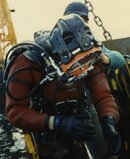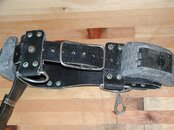No, he's certainly not insisting. And I think his opinion of Miller is quite good, except in the case of this particular harness. He pointed out that the rubber backplate offers very little in the way of support for your tank, making it unstable, and that it was barely adjustable. He also added that he didn't understand why the North Sea Bell/Backpack Harness was named so because integrated tank harnesses are not allowed; I guess he was referring to the "North Sea" part?
You are using an out of date browser. It may not display this or other websites correctly.
You should upgrade or use an alternative browser.
You should upgrade or use an alternative browser.
Beginner Diver Seeks Advice About Wing & BP Setup
- Thread starter torvum
- Start date
Please register or login
Welcome to ScubaBoard, the world's largest scuba diving community. Registration is not required to read the forums, but we encourage you to join. Joining has its benefits and enables you to participate in the discussions.
Benefits of registering include
- Ability to post and comment on topics and discussions.
- A Free photo gallery to share your dive photos with the world.
- You can make this box go away
E-gads. The OP has fewer than 24 dives. Way off the mark here.
If I am not mistaken, this is a commercial rig?
Sorry, my original post wasn't clear. Basically my commercial diving program has a couple components. A shorter SCUBA component, and a much longer surface-supplied (SS) components. The SS component requires for me to have a CSA approved, strength-rated personal diving harness. I thought I could kill 2 birds with one stone if I could use that same harness for my SCUBA component, by rigging it with a backplate and wing, so that I could avoid purchasing another harness (or BC, for that matter.)
Hello,
I Googled "CSA Diving Harness", and this came up first on the list, so I felt compelled to sign on and clarify.
The CSA, Canadian Standards association has recently introduced new standards for personal diving harnesses (PDH).
IMCA has also developed similar standards. Prior to that, there were no standards that I am aware of, and certainly none with documented ratings and testing. It seems rather odd that there are strength ratings for all manner of equipment, (umbilical strength members, etc) but none for harnesses.
I quoted the applicable parts of the standard, but have since removed it- I'm not sure if it is violating any policies, will consult CSA...
The Diving School in question is accredited by the DCBC a worldwide recognised independent certifying body that ensures that accredited training institutions conform to the CSA standards. Therefore the school is obligated to follow the standards.
It is in no way endorsing this particular harness, it just happened to be the first one through the gate when the standards were introduced. If other harnesses conform, they are permitted.
The Miller harness is not, by a long shot. (Ben's weight belts are awesome though, had mine almost 20 years now!) It has no weight rating and isn't very adjustable because it is riveted. The theory that riveting is stronger than proper stiching is completely false. By riveting, you are puncturing the material, creating stress points. Stitching does not. Don't believe me? I challenge you to find a fall arrest harness, rock climbing harness or parachute harness that is riveted. Furthermore, try to find a weight rated fiber sling used in rigging and hoisting that is riveted. You won't.
Present best industry practice in the case of bell diving as stated, has come about as a result of a few incidents in the North Sea (I apologise, I don't have the IMCA bulletin handy) A crew was attempting to recover a diver to the bell, but were unable to ditch the bailout bottle etc, because it was attached to the recovery harness. Now divers are required to wear a harness UNDER the belljacket etc, so all gear can be stripped off whilst still maintaining control of the stricken diver.
The CSA standard isn't an offshore diving standard, it covers all aspects of diving including civils, so integrated harnesses are permitted, though not ideal in all situations. Yes, a stage is ideal, and mandated in the standard after a deck to water height of 3m. But what about 2.5m? Everybody here knows damn well a construction outfit will make you climb the ladder... therefore hoisting may be required in the event of an emergency, if even for a short distance. Ideal? No. An industry reality? Yes.
So... I hope this clarifies the reasoning behind the school's decision to mandate approved harnesses.
I Googled "CSA Diving Harness", and this came up first on the list, so I felt compelled to sign on and clarify.
The CSA, Canadian Standards association has recently introduced new standards for personal diving harnesses (PDH).
IMCA has also developed similar standards. Prior to that, there were no standards that I am aware of, and certainly none with documented ratings and testing. It seems rather odd that there are strength ratings for all manner of equipment, (umbilical strength members, etc) but none for harnesses.
I quoted the applicable parts of the standard, but have since removed it- I'm not sure if it is violating any policies, will consult CSA...
The Diving School in question is accredited by the DCBC a worldwide recognised independent certifying body that ensures that accredited training institutions conform to the CSA standards. Therefore the school is obligated to follow the standards.
It is in no way endorsing this particular harness, it just happened to be the first one through the gate when the standards were introduced. If other harnesses conform, they are permitted.
The Miller harness is not, by a long shot. (Ben's weight belts are awesome though, had mine almost 20 years now!) It has no weight rating and isn't very adjustable because it is riveted. The theory that riveting is stronger than proper stiching is completely false. By riveting, you are puncturing the material, creating stress points. Stitching does not. Don't believe me? I challenge you to find a fall arrest harness, rock climbing harness or parachute harness that is riveted. Furthermore, try to find a weight rated fiber sling used in rigging and hoisting that is riveted. You won't.
Present best industry practice in the case of bell diving as stated, has come about as a result of a few incidents in the North Sea (I apologise, I don't have the IMCA bulletin handy) A crew was attempting to recover a diver to the bell, but were unable to ditch the bailout bottle etc, because it was attached to the recovery harness. Now divers are required to wear a harness UNDER the belljacket etc, so all gear can be stripped off whilst still maintaining control of the stricken diver.
The CSA standard isn't an offshore diving standard, it covers all aspects of diving including civils, so integrated harnesses are permitted, though not ideal in all situations. Yes, a stage is ideal, and mandated in the standard after a deck to water height of 3m. But what about 2.5m? Everybody here knows damn well a construction outfit will make you climb the ladder... therefore hoisting may be required in the event of an emergency, if even for a short distance. Ideal? No. An industry reality? Yes.
So... I hope this clarifies the reasoning behind the school's decision to mandate approved harnesses.
Last edited:
The theory that riveting is stronger than proper stiching is completely false. By riveting, you are puncturing the material, creating stress points...
The purpose of rivets was not because they are stronger than sewing, it was for chemical resistance. The problem with sewing is petrochemicals floating on the surface of the water will attack the thread and cause failures that are very difficult to see. The problem is compounded by contaminated water trapped between webbing layers that is extremely difficult to clean or wash out. That provides time for the chemicals to act on the tiny cross-section of the thread.
Miller used a super-heavy impregnated black webbing; the softer blue webbing was introduced years later. Water and floating chemicals would visually bead up on the black webbing in addition to being much more abrasion resistant. I dont think they offer that material since Kirby-Morgan bought them after Ben passed away.
It would be easy to make a harness from 1" hardware store webbing and copper rivets that was strong enough to tear a body in half. That same harness would fall apart in a few years of use/abuse. Ben Miller was a diver in the Gulf for years and understood the level of abuse this gear sees.
It was very common in the late 1960s for divers to make their own harness and weight belts from conveyor belting and brass rivets from a marine supply. A Gulf diver taught me in the early 1970s and I found an aero-space supplier with stainless rivets. Im wearing that harness and belt in my Avatar and used that belt on recreational dives this weekend.
Attachments
Similar threads
- Replies
- 50
- Views
- 3,543
- Replies
- 0
- Views
- 133
- Replies
- 17
- Views
- 1,905
- Replies
- 26
- Views
- 2,732






